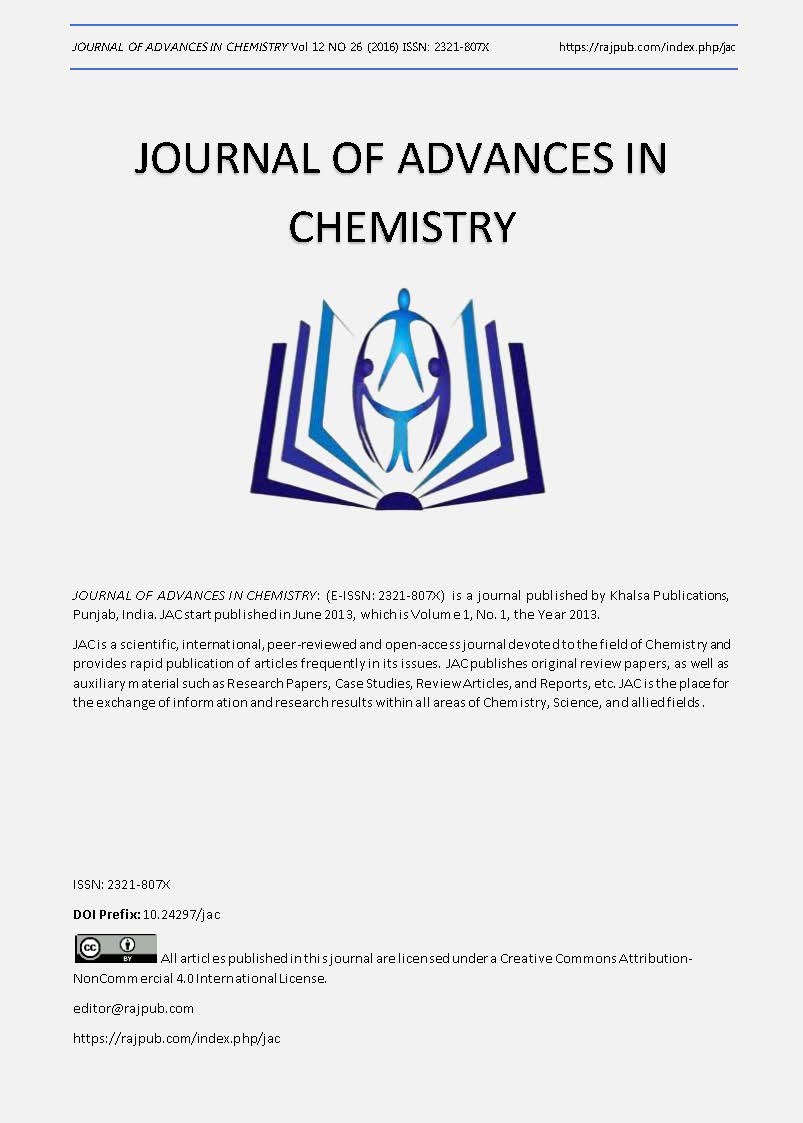Enhanced Antimicrobial activities of Hybrid ZnMgAlO nanocomposite by soft chemical method
DOI:
https://doi.org/10.24297/jac.v12i26.993Keywords:
soft chemical method, ZnMgAlO nanoparticles, anti-bacterial and anti-fungal activities.Abstract
In the present investigation, ZnMgAlO nanoparticles were prepared by soft chemical method. The synthesized NPs were analyzed by XRD and SEM EDAX. ZnMgAlO crystal structure was confirmed through powder XRD technique as hexagonal wurtzite structure. The surface morphology was analyzed from SEM images. Finally, antimicrobial activity of all the synthesized samples was tested against Bacillus subtilis and Chlamydia trachomatis bacteria and Xylaria hypoxylon, Fistulina hepatica fungus. The observed results showed good anti-bacterial and anti-fungal activities. Â
Downloads
References
2. Chandrappa, K. G., Venkatesha, T. V., Vathsala, K., & Shivakumara, C. (2010). A hybrid electrochemical–thermal method for the preparation of large ZnO nanoparticles. Journal of Nanoparticle Research, 12(7), 2667-2678.
3. Singh, S. C., & Gopal, R. (2008). Synthesis of colloidal zinc oxide nanoparticles by pulsed laser ablation in aqueous media. Physica E: Low-dimensional Systems and Nanostructures, 40(4), 724-730.
4. Sun, Y., Riley, D. J., & Ashfold, M. N. (2006). Mechanism of ZnO nanotube growth by hydrothermal methods on ZnO film-coated Si substrates. The Journal of Physical Chemistry B, 110(31), 15186-15192.
5. Usui, H., Shimizu, Y., Sasaki, T., & Koshizaki, N. (2005). Photoluminescence of ZnO nanoparticles prepared by laser ablation in different surfactant solutions.The Journal of Physical Chemistry B, 109(1), 120-124.
6. Guo, J., Li, Y., Hu, D., & Liu, H. (2014). Preparation of transition-metal-doped ZnO nanophotocatalysts and their performance on photocatalytic degradation of antibiotic wastewater. Desalination and Water Treatment, (ahead-of-print), 1-8.
7. Liu, Y., He, L., Mustapha, A., Li, H., Hu, Z. Q., & Lin, M. (2009). Antibacterial activities of zinc oxide nanoparticles against Escherichia coli O157: H7. Journal of Applied Microbiology, 107(4), 1193-1201.
8. Rezaei-Zarchi, S., Javed, A., Javeed Ghani, M., Soufian, S., Barzegari Firouzabadi, F., Bayanduri Moghaddam, A., & Mirjalili, S. H. (2010). Comparative study of antimicrobial activities of TiO2 and CdO nanoparticles against the pathogenic strain of Escherichia coli. Iranian Journal of Pathology, 5(2), 83-89.
9. Raghupathi, K. R., Koodali, R. T., & Manna, A. C. (2011). Size-dependent bacterial growth inhibition and mechanism of antibacterial activity of zinc oxide nanoparticles. Langmuir, 27(7), 4020-4028.
10. Satheeskumar, S., Ramesh, K., & Srinivasan, N. (2014). Exploration of synthesis, structural, morphology and antibacterial activity of Zn1-xy Mgx Aly O nanoparticles.
11. Aneesh, PM, Vanaja, KA & Jayaraj, MK 2007, ‘Synthesis of ZnO nanoparticles by hydrothermal method. In NanoScience+ Engineering’, International Society for Optics and Photonics, vol. 6639, pp. 66390J.
Downloads
Published
How to Cite
Issue
Section
License
 All articles published in Journal of Advances in Linguistics are licensed under a Creative Commons Attribution 4.0 International License.
All articles published in Journal of Advances in Linguistics are licensed under a Creative Commons Attribution 4.0 International License.




